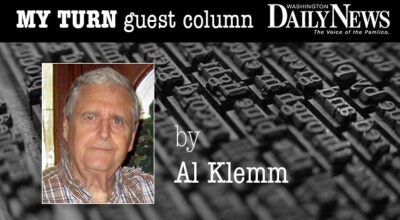Write Again … That’s how it was
Published 4:43 pm Friday, February 22, 2019
Among my very best and most enduring memories are the years that I helped my friend Howard Chapin with the Washington High School jayvee football teams; and when I coached the school’s track and field teams.
I am grateful beyond measure to have had those experiences, and will always remember these special young people from over a half-century ago.
We who have such good memories are blessed. They were the best of times — but not for everyone.
A case in point.
When I would take the WHS track teams to the yearly Duke-Durham Relays — a really large, first class event for high schools — there was one serendipitous benefit.
One of my very good friends, just a little older than I, always drove our bus. And when we would all grab a bite in one of the Duke dining halls he could eat with us. That was very important to me.
You see — many of you remember — most reputable places having a sit-down eating environment didn’t serve black people.
Such an awareness of the unfairness of that would make me recall the late April night in 1959 when those of us who had just been inducted into the army arrived by train at Columbia, South Carolina.
We were to be picked up by army personnel and taken to Fort Jackson. Our transportation hadn’t arrived, and most of us were hungry.
There was a light on at a small grill near where we got off the train. A small food oasis still open.
Plainly visible was a little sign that proclaimed “Whites Only.” I remember the expression on the faces of the black fellows when they saw that sign. Many of them had come from the Philadelphia area, and probably other places above the “Smith & Wesson” line.
Some of the others went over to the grill. The “unwelcome” young men, several of them, just sat down outside by the curb.
There was no way I was going to get something to eat. I sat down with them. We didn’t talk about the situation. We just waited for our transportation to Fort Jackson.
Such signs as the one we saw that night were manifestations of Jim Crow Laws.
Such reprehensible exclusionary laws included the physical segregation of public schools, public parks and beaches, and public transportation.
It was also during this time that drinking fountains, restrooms, and restaurants were segregated, requiring people of color to use separate facilities.
In some states, parts of state constitutions mandated Jim Crow laws. These laws were in a number of states requiring segregation from 1876-1965.
Any of my readers born less than 50 or more years ago probably know little or nothing about the Jim Crow laws. (And most certainly there are very few if any in that demographic who read this column, or even read a newspaper. That’s another story.)
Giving the origin of the Jim Crow laws, telling who Jim Crow was, is something I do not have enough space allocation in our paper to share with you in just one column.
Those early days in my coaching career — very special to me — were the best of times.
But not for everyone.



